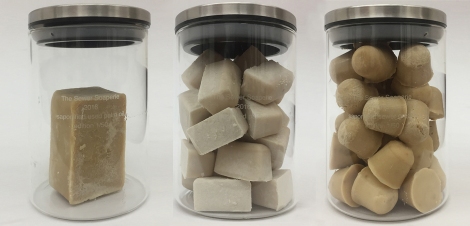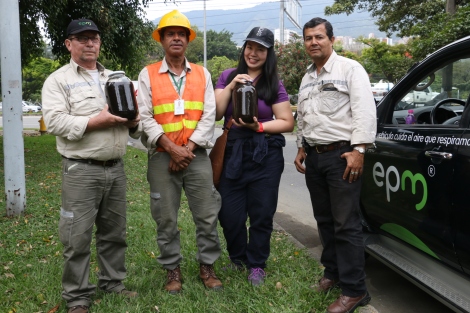This post comes from the Artists and Climate Change Blog
By Guest Blogger Catherine Sarah Young
When you experience something that ticks you off, I’d recommend doing a project on it.
I was stuck in ankle-deep waters on one fateful day in Manila. It had rained for only a few minutes, but already traffic was at a standstill. The sewers were blocked – yet again! – and when the arteries are clogged, you can see the signs of an urban heart attack. All streets and alleyways within sight were impassable. Everywhere I saw people standing on higher ground, staring at the increasing water line in dismay.
The only ones cheering were the drivers of pedicabs, informal transport consisting of a bike and a small hooded cab for a passenger. They knew they could charge triple the normal fare because people were desperate. (To be fair, you’d have to be really cruel not to tip them well; it is quite heroic to pedal through weather like this.)
The many reasons for this blockage include how used cooking oil is improperly discarded in the sewers. It coagulates together with other objects that won’t break down right away, such as wet wipes and sanitary items. These blobs of fat have been nicknamed “fatbergs†in some cities.
It is these little apocalypses that make me do art about climate change. The Philippines, in the path of many typhoons especially with global warming, will only get more unlivable if behaviors go unchecked. And so, wet, grumpy, and miserable in the cold, I vowed to turn that experience into another piece.
A few weeks later, I was in Medellin on a residency for The Apocalypse Project. This Colombian city is quite the success story, having overcome a troubled history to win the 2016 Lee Kuan Yew World City Prize and 2013 Most Innovative City by Urban Land Institute, thanks to a renaissance in urban planning. Thankfully, in spite of many rainy nights during my month-long stay, Medellin did not get flooded the way Manila does and the sewage system seems to be well-maintained.
Manila and Medellin share similarities in both history and culture. And so I was interested to see how two cities can be so similar and different. My residency hosts, Platohedro and Casa Tres Patios, were able to get me more information about the city sewers, and one day I found myself staring down an open manhole. One engineer from EPM, the company that manages the city sewers, actually gave me access, and even gave me some samples for my research. I had never been so thrilled to receive a jar of sewage in my life.
I also got to visit the polluted Medellin River, which seems to be used as an alternative sewer by nearby residents. It was mostly water, but I was able to get some lipid samples.
After my residency, I went back to Manila to apply what I had learned in Medellin. It was difficult to get permission to open up the sewers in Manila, and indeed I had many a security guard shoo me away as I tried to pry some manholes open. Undeterred, I found some sewage in many open pipes in this city that gives one a lot of apocalyptic inspirations.
In the studio, I combined the sewage I collected from Manila and Medellin. I filtered and boiled the sewage to kill as many bacteria and pathogens as possible, but I still wore safety clothing, not unlike the pieces shown in Climate Change Couture published on this blog. Soap is the salt of a fatty acid, so most soap recipes would call for any oil with an appropriate amount of lye or caustic soda. There was a lot of trial and error in searching for the right amount of lye, especially since I did not know the exact composition of these samples. Some experiments didn’t produce soap at all, while others saponified and, to my horror, started growing out of the molds. Some had layers of fat in them, looking a bit geological.
Finally, I had enough soap bars and small samples to exhibit. I exhibited these in 1335Mabini, a space for contemporary art in Manila, and at the Climate-Resilient International Development Exchange in Bangkok in USAID Asia. A hazard warning cautioned people against touching the samples. A few did anyway, gingerly, and someone told me they smelled like cookies. I would never touch these without gloves as I know their previous state too well.
As an artist, it was interesting to see how people interacted with a project whose subject matter isn’t really discussed. People would gather, without me having to say anything, to examine the freaky objects displayed on a plinth and then engage in conversation about the cooking oil they use, traffic, and the myriad of other systemic problems of cities.
Improper waste disposal is one of the tiny behaviors whose consequences eventually interfere with everyone’s lives, and yet we usually blame other people for it. The value of art is that it gives us a platform to reflect on ourselves and our relationship with nature and our cities. To negotiate our place in the Anthropocene, we need to change our habits and make our systems work better.
Research for this project was made possible by a residency at Platohedro and Casa Tres Patios, with support from Arts Collaboratory and the Ministry of Culture of Colombia.
Thanks to Mr. Hemel Serna of EPM and his team for giving me administrative support in researching Medellin’s sewer systems.Â
______________________________
Catherine Sarah Young is an artist, designer, researcher, and writer whose work explores emerging technologies and alternative futures through interactive storytelling and sensory experiences. Her experimental and interdisciplinary practice evokes conversation about our collective futures and individual choices. As an artist and designer, she has collaborated with scientists, companies, chefs, artists, think tanks, and museums around the world. As a writer, she creates worlds through science fiction and design futures, exploring themes related to the environment, feminism, and future technologies. She is the founder of The Apocalypse Project, a creative platform that explores climate change and environmental futures.
Artists and Climate Change is a blog that tracks artistic responses from all disciplines to the problem of climate change. It is both a study about what is being done, and a resource for anyone interested in the subject. Art has the power to reframe the conversation about our environmental crisis so it is inclusive, constructive, and conducive to action. Art can, and should, shape our values and behavior so we are better equipped to face the formidable challenge in front of us.






